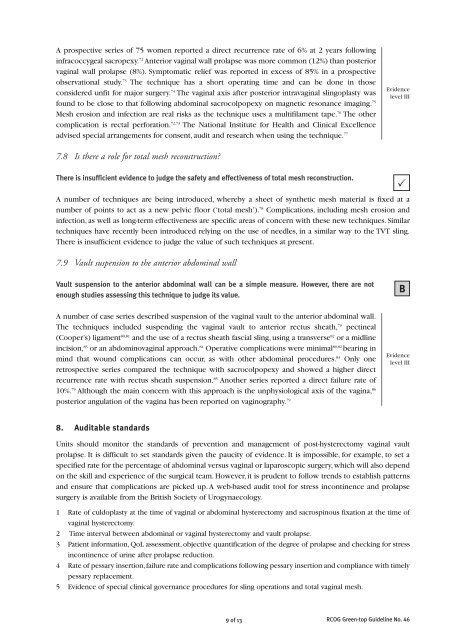The Management of Post Hysterectomy Vaginal Vault Prolapse ...
The Management of Post Hysterectomy Vaginal Vault Prolapse ...
The Management of Post Hysterectomy Vaginal Vault Prolapse ...
Create successful ePaper yourself
Turn your PDF publications into a flip-book with our unique Google optimized e-Paper software.
A prospective series <strong>of</strong> 75 women reported a direct recurrence rate <strong>of</strong> 6% at 2 years followinginfracoccygeal sacropexy. 72 Anterior vaginal wall prolapse was more common (12%) than posteriorvaginal wall prolapse (8%). Symptomatic relief was reported in excess <strong>of</strong> 85% in a prospectiveobservational study. 73 <strong>The</strong> technique has a short operating time and can be done in thoseconsidered unfit for major surgery. 74 <strong>The</strong> vaginal axis after posterior intravaginal slingoplasty wasfound to be close to that following abdominal sacrocolpopexy on magnetic resonance imaging. 75Mesh erosion and infection are real risks as the technique uses a multifilament tape. 76 <strong>The</strong> othercomplication is rectal perforation. 72,73 <strong>The</strong> National Institute for Health and Clinical Excellenceadvised special arrangements for consent, audit and research when using the technique. 77Evidencelevel III7.8 Is there a role for total mesh reconstruction?<strong>The</strong>re is insufficient evidence to judge the safety and effectiveness <strong>of</strong> total mesh reconstruction.A number <strong>of</strong> techniques are being introduced, whereby a sheet <strong>of</strong> synthetic mesh material is fixed at anumber <strong>of</strong> points to act as a new pelvic floor (‘total mesh’). 78 Complications, including mesh erosion andinfection, as well as long-term effectiveness are specific areas <strong>of</strong> concern with these new techniques. Similartechniques have recently been introduced relying on the use <strong>of</strong> needles, in a similar way to the TVT sling.<strong>The</strong>re is insufficient evidence to judge the value <strong>of</strong> such techniques at present.7.9 <strong>Vault</strong> suspension to the anterior abdominal walľ<strong>Vault</strong> suspension to the anterior abdominal wall can be a simple measure. However, there are notenough studies assessing this technique to judge its value.A number <strong>of</strong> case series described suspension <strong>of</strong> the vaginal vault to the anterior abdominal wall.<strong>The</strong> techniques included suspending the vaginal vault to anterior rectus sheath, 79 pectineal(Cooper’s) ligament 80,81 and the use <strong>of</strong> a rectus sheath fascial sling, using a transverse 82 or a midlineincision, 83 or an abdominovaginal approach. 84 Operative complications were minimal 80,82 bearing inmind that wound complications can occur, as with other abdominal procedures. 83 Only oneretrospective series compared the technique with sacrocolpopexy and showed a higher directrecurrence rate with rectus sheath suspension. 85 Another series reported a direct failure rate <strong>of</strong>10%. 79 Although the main concern with this approach is the unphysiological axis <strong>of</strong> the vagina, 86posterior angulation <strong>of</strong> the vagina has been reported on vaginography. 79BEvidencelevel III8. Auditable standardsUnits should monitor the standards <strong>of</strong> prevention and management <strong>of</strong> post-hysterectomy vaginal vaultprolapse. It is difficult to set standards given the paucity <strong>of</strong> evidence. It is impossible, for example, to set aspecified rate for the percentage <strong>of</strong> abdominal versus vaginal or laparoscopic surgery, which will also dependon the skill and experience <strong>of</strong> the surgical team. However, it is prudent to follow trends to establish patternsand ensure that complications are picked up. A web-based audit tool for stress incontinence and prolapsesurgery is available from the British Society <strong>of</strong> Urogynaecology.1 Rate <strong>of</strong> culdoplasty at the time <strong>of</strong> vaginal or abdominal hysterectomy and sacrospinous fixation at the time <strong>of</strong>vaginal hysterectomy.2 Time interval between abdominal or vaginal hysterectomy and vault prolapse.3 Patient information, QoL assessment, objective quantification <strong>of</strong> the degree <strong>of</strong> prolapse and checking for stressincontinence <strong>of</strong> urine after prolapse reduction.4 Rate <strong>of</strong> pessary insertion, failure rate and complications following pessary insertion and compliance with timelypessary replacement.5 Evidence <strong>of</strong> special clinical governance procedures for sling operations and total vaginal mesh.9 <strong>of</strong> 13 RCOG Green-top Guideline No. 46
















